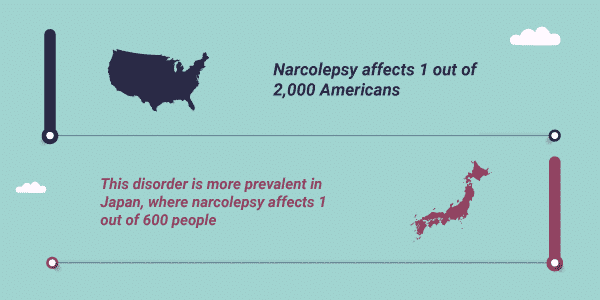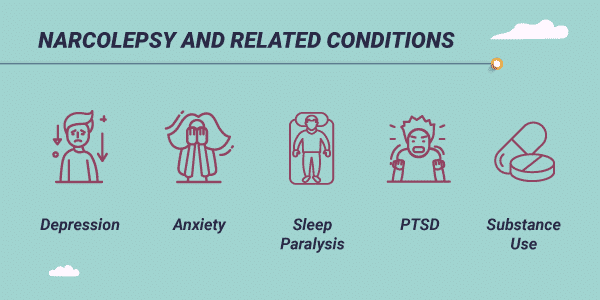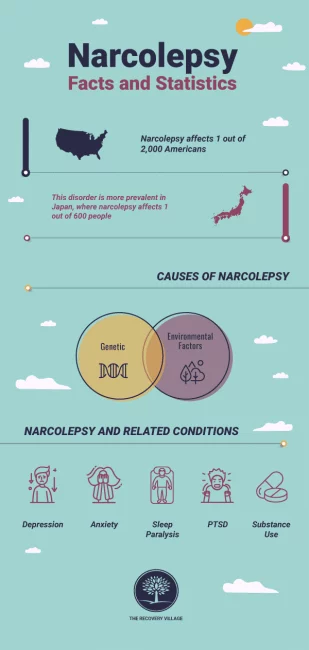Do you often fall asleep in the middle of activities? You may be suffering from narcolepsy. Read about narcolepsy facts and statistics to learn more.
Narcolepsy is a type of neurological sleep disorder whereby the brain cannot regulate sleep-wake cycles. People suffering from narcolepsy are known to fall asleep at inappropriate times, like while having a conversation, driving or eating a meal. Recent clinical and epidemiological studies provide a better understanding of narcolepsy with the most up-to-date narcolepsy facts and statistics.
How Common is Narcolepsy?
The prevalence of a disease is a measure of how common that disease is in a given population. Narcolepsy affects 1 out of 2,000 Americans and 3 million people worldwide. Interestingly, this disorder is more prevalent in Japan, where roughly 1 out of 600 people suffer from narcolepsy.
The onset of narcolepsy typically occurs between the ages of 10–30 and impacts men and women equally.
Narcolepsy is thought to be caused by both genetic and environmental factors related to the immune system, though its specific cause is unknown. Some of these factors differ based on the type of narcolepsy.

Types of Narcolepsy
Currently, there are three different types of narcolepsy. The two most common forms of the condition differ based on a condition known as cataplexy. A third type, known as secondary narcolepsy, can develop after a brain injury.
- Type 1: Type 1 narcolepsy is formerly known as narcolepsy with cataplexy. Cataplexy is defined as a sudden uncontrollable paralysis in the muscles of the face, arms, legs or core. It is usually brought on by a change in emotional state, such as laughing. Cataplexy is attributed to low levels of a brain hormone known as hypocretin. The main role of hypocretin is to regulate rapid eye movement (REM) sleep, which is a critical component of healthy sleep.
- Type 2: Type 2 narcolepsy is similar to type 1 except that no cataplexy is present and hypocretin levels are normal. Symptoms such as excessive tiredness, hallucinations while falling asleep or waking up, sleep paralysis and vivid dreams are common in both type 1 and type 2 narcolepsy.
- Secondary Narcolepsy: Secondary narcolepsy may develop after an injury to the hypothalamus, a region in the brain responsible for sleep regulation.
Narcolepsy Misdiagnosis
A study from 2016 found that of patients with a confirmed narcolepsy diagnosis, almost 50% were misdiagnosed. This study demonstrates that there is a desperate need to improve diagnostic criteria for the disorder. A misdiagnosis of narcolepsy has long-term implications, such as limited employment options, unnecessary use of prescriptions, insurance-related issues and inability to drive. To accurately diagnose narcolepsy, medical professionals must take a detailed medical history, conduct a physical examination and recommend a sleep study.
Various sleep study tests are used in the diagnosis of narcolepsy. The most common tests include:
- Polysomnogram: A polysomnogram is performed overnight at a sleep center. These test monitors brain activity to determine how quickly patients fall asleep or enter REM sleep.
- Multiple Sleep Latency Test: This test takes place in the daytime after a full night of sleep and is used to determine how quickly a patient falls asleep, even after adequate rest.
- Spinal Tap: A spinal tap may be performed to determine hypocretin levels in the spinal fluid.
Narcolepsy and Related Conditions
Narcolepsy has a specific set of signs and symptoms, causes, diagnosis and treatment, some of which overlap with related conditions. Some of these associated conditions include:
- Depression: Since the 1970s, it has been known that narcolepsy is associated with an increased risk of depression, potentially through a mechanism involving hypocretin.
- Anxiety: A study published in 2010 found that 35% of narcoleptics met diagnostic criteria for an anxiety disorder, regardless of age or sex.
- Sleep Paralysis: Sleep paralysis is often a symptom of narcolepsy. Narcoleptics may experience sleep paralysis and hallucinations while falling asleep or waking up.
- Post-Traumatic Stress Disorder (PTSD): Otherwise known as PTSD, there are potential links involving REM sleep cycles between this disorder and narcolepsy
- Substance and Alcohol Use: There has been at least one case study whereby heavy alcohol use was thought to bring about the development of narcolepsy; however, there are currently not enough studies available to determine causal linkages between substance use and narcolepsy.

Narcolepsy and Driving
Driving with narcolepsy can pose a serious safety risk to oneself and others if the disorder is not properly managed. The Nexus Narcolepsy Registry determined that while 94% of narcoleptics used their prescribed narcolepsy medication, almost 35% were involved in at least one motor vehicle accident. In the United States, different states have different rules about driving with narcolepsy.
Narcolepsy Research and Prognosis
Currently, there is no cure for narcolepsy, nor do symptoms of the condition dissipate over time. However, scientists and medical professionals are actively conducting research and sleep studies to better understand this disorder.
A recent study profiled blood from narcoleptic patients and found an elevated immune response in these individuals. Another study involving rodents suggested that certain components of the immune system were attacking proteins necessary for hypocretin response, leading to narcoleptic symptoms in these mice. This data further supports the crucial role of the immune system in narcolepsy.
According to Harvard Health, the prognosis for narcolepsy is bleak if the disease is not managed correctly, namely because narcoleptics are at a much higher risk for work-related injuries or motor vehicle accidents than members of the general population.
Statistics on Narcolepsy Treatment
It is estimated that the narcolepsy is probably underdiagnosed, with only 25% of people currently seeking treatment. This gap in treatment may be attributed to people who experience mild narcolepsy symptoms and do not seek medical care. Nevertheless, there are numerous treatments for narcolepsy depending on the symptoms and type of narcolepsy.
Medical professionals use the current standard of care as a guideline for treating all patients diagnosed with narcolepsy:
- Both type 1 and type 2 narcolepsy can be treated with stimulants and scheduled naps to prevent daytime sleepiness. Stimulants like amphetamine salts are most effective at doses between 5-60 milligrams.
- Type 1 narcolepsy or sleep paralysis can be treated effectively with antidepressants at varying doses.
- Symptoms of type 1 narcolepsy can be addressed with a neurotransmitter called gamma hydroxybutyrate, which is most effective at split doses (one day and one nighttime dose) between 4.5–9 grams.
It is likely that, in the near future, treatments for narcolepsy will target specific components of the immune system. Until then, the best treatments for narcolepsy are the current standards of care aimed at reducing symptoms and improving the individual’s safety.
If you or a loved one are struggling with co-occurring addiction and narcolepsy, The Recovery Village can help. You can receive comprehensive treatment for these co-occurring disorders from one of the facilities located throughout the country. To learn more about treatment programs, call The Recovery Village to speak with a representative today.


Division of Sleep Medicine at Harvard Medical School. “The Science of Narcolepsy.” February 21, 2018. Accessed April 21, 2019.
Genetics Home Reference. “Narcolepsy.” April 16, 2019. Accessed April 21, 2019.
Gen Hosp Psychiatry. “Anxiety and mood disorders in narcolepsy[…] case-control study.” January-February 2010. Accessed April 21, 2019.
Harvard Health. “Narcolepsy.” January 2019. Accessed April, 2019.
Journal of Anxiety Disorders. “Divergence of PTSD and narcolepsy associated with military trauma.” 1991. Accessed April 21, 2019.
The Journal of Physiological Anthropology. “Daily rhythms of the sleep-wake cycle.” March 13, 2012. Accessed April 21, 2019.
Journal of Experimental Medicine. “High-dimensional single-cell analysis re[…]nature of narcolepsy.” November 14, 2016. Accessed April 21, 2019.
Narcolepsy Network. “Narcolepsy Fast Facts.” June 2015. Accessed April 21, 2019.
National Institutes of Health. “Narcolepsy.” November 9th, 2011. Accessed April 21, 2019.
National Institutes of Health. “Narcolepsy Fact Sheet.” July 6, 2018. Accessed April 21, 2019.
National Institutes of Health. “Prevalence.” November 2017. Accessed April 21, 2019.
National Institutes of Health. “What is REM sleep?” December 1, 2016. Accessed April 21, 2019.
National Sleep Foundation. “Cataplexy.” Accessed April 21, 2019.
National Sleep Foundation. “Hallucinations and Sleep Paralysis.” Accessed April 21, 2019.
Neuroepidemiology. “A case-control study of the environmenta[…]ctors for narcolepsy.” 2007. Accessed April 21, 2019.
Neurology. “Prevalence of narcolepsy symptomatology […]n general population.” June 25, 2002. Accessed April 21, 2019.
Proc Natl Acad Sci USA. “CD8 T cell-mediated killing of orexinerg[…]ke phenotype in mice.” September 27, 2016. Accessed April 21, 2019.
Rev Neurol. “Environmental factors in the development[…]A case-control study.” June 16, 2015. Accessed April 21, 2019.
Schweiz Arch Neurol Neurochir Psychiatr. “Depression in narcolepsy and hypersomnia.” 1975. Accessed April 21, 2019.
Shanghai Arch Psychiatry. “Narcolepsy induced by chronic heavy alco[…]ption: a case report.” 2012. Accessed April 21, 2019.
Sleep. “0629 Injuries, Motor Vehicle Accidents, […]Narcolepsy Registry.” April 2018. Accessed April 21, 2019.
Sleep. “Smoking, Alcohol, Drug Use, Abuse and De[…]A Case-Control Study.” March 1, 2016. Accessed April 21, 2019.
Sleep & Breathing. “Misdiagnosis of narcolepsy.” June 23, 2016. Accessed April 21, 2019.
Sleep Science. “Current and Future Treatment Options for[…]Narcolepsy: A Review.” January–March 2017. Accessed April 25, 2019.
UCSF Health. “Neurological Disorders.” Accessed April 21, 2019.
The Recovery Village aims to improve the quality of life for people struggling with substance use or mental health disorder with fact-based content about the nature of behavioral health conditions, treatment options and their related outcomes. We publish material that is researched, cited, edited and reviewed by licensed medical professionals. The information we provide is not intended to be a substitute for professional medical advice, diagnosis or treatment. It should not be used in place of the advice of your physician or other qualified healthcare providers.
